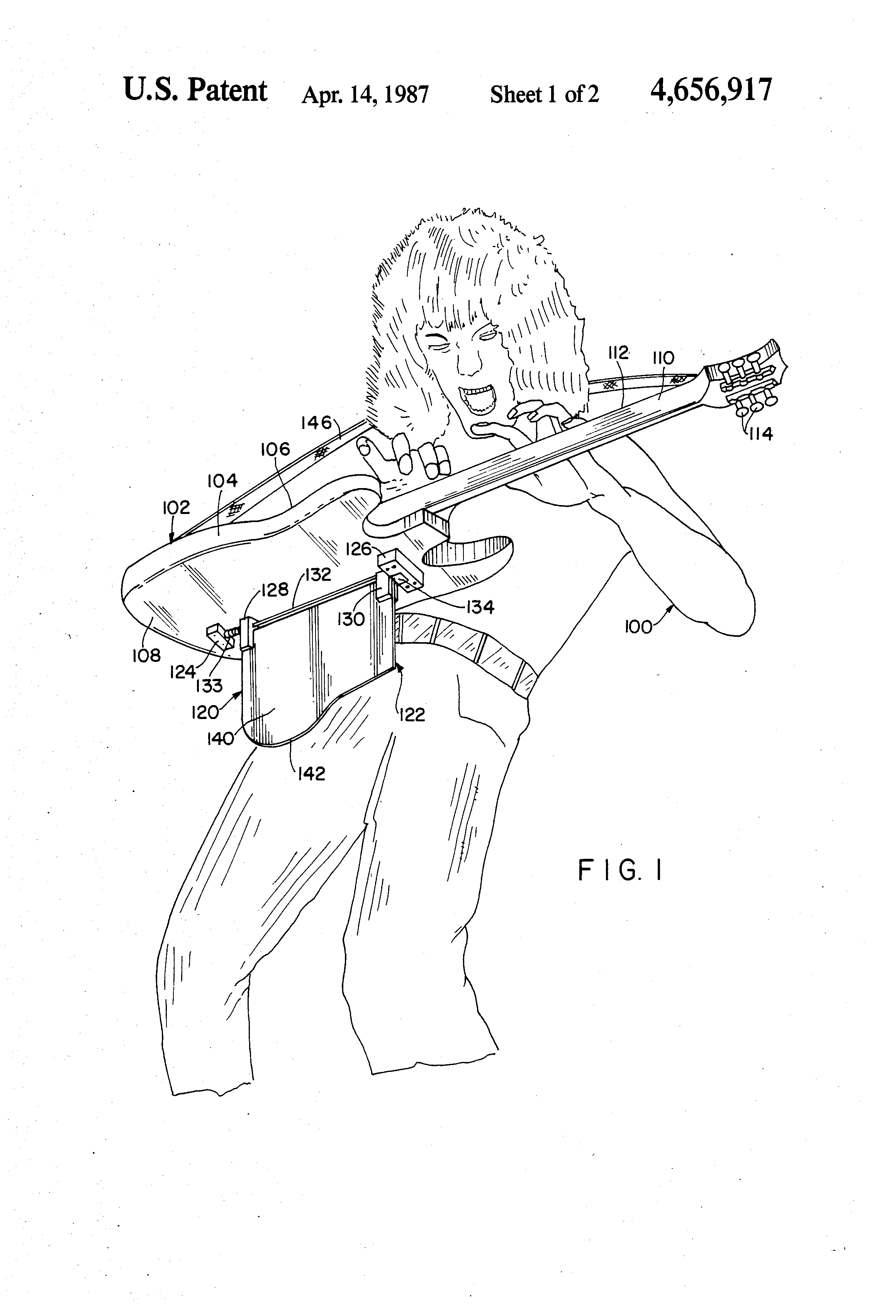When people think about musicians, they usually don’t think inventor. But some musicians broke the mold when they patented their inventions. Let’s explore these true renaissance people. We should make note of these talented folks who generally own both copyright on their music (and sound recordings) AND patents on their inventions
Wait, What’s a Patent?
A patent is a type of intellectual property that protects inventions. To get a patent, an inventor must apply for one and convince a government agency that a patent is deserved. In the US, the agency that grants patents is the United States Patent and Trademark Office (USPTO). A patent gives the patent holder the right to exclude others from “making, using, offering for sale, or selling” (and importing) the patented invention in the United States during the patent term.
There are two types of patents: utility and design. Utility patents are what most people refer to when they speak of patents. This type of patent protects a new and useful things and methods or improvements on existing inventions. These patents last for 20 years from the date the patent application is filed.
Design patents on the other hand, protect new and original “ornamental designs” on products . As opposed to the function or utility of the invention, design patents only cover the aesthetic and visual qualities, i.e. how something looks. These types of patents currently have only a 15 year term from the date of issuance, as opposed to the 20 of utility patents.
Some of the musicians below have design patents, while others have utility patents. If you’re interested in learning more, check out some of the resources from the USPTO!
The King of Pop and His Royal Shoes
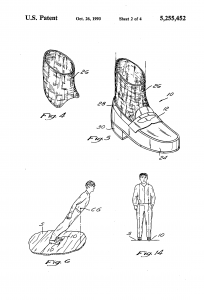

When Michael Jackson’s “Smooth Criminal” music video came out, people were awed by his seemingly gravity-defying dance moves. Was it cables that let him lean like that? Movie making effects? Pure core strength? It turns out, the power was all in the shoes.
In 1992, MJ, along with Dennis Tompkins and Michael L. Bush, patented a “Method and means for creating anti-gravity illusion” (US 5,255,452) which used a special boot enabling wearers to lean at extreme angles. The footwear had a special heel attachment that could be detached when the wearer slid their foot forward, activating a hitch. This would then connect with a segment of the stage to anchor the performer, allowing them to lean well past the usual center of gravity. The effect, was electrifying.
While My Keytar Gently Weeps
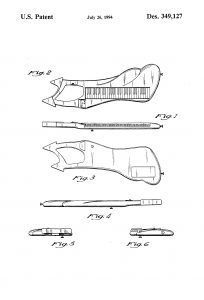
One of the coolest to ever grace the stage also created one of the coolest patents to hit the USPTO. I’m talking about the man with the raspberry beret, Prince!
In 1994, the “Purpleaxxe” (D349,127) – a portable electronic keyboard with a unique “Princeian” design – was officially registered to Prince Rogers Nelson of Minnesota, the “Purple Rain” singer himself. The keytar uses elements from the Prince glyph, which represented him when he was the artist formerly known as Prince, and of course is clad in purple. It’s unclear if the keytar made doves cry, but the design is certainly one of “The Beautiful Ones.”
Interested in making your own Purpleaxxe? You’re in luck – the patent expired in 2008.
Locomotin’ in the Free World
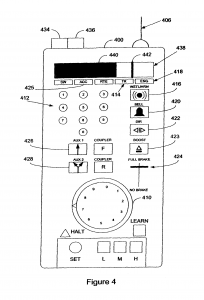
Did you know one of the greatest songwriters of all time was also a ferroequinologist (a train enthusiast)? He may have ridden a “Horse With No Name,” but Neil Young also was a fanatic for model trains.
In fact, Young was part owner of a company that created model trains and accessories. It was through this that Young was listed as a co-creator on seven U.S. patents for model trains. One of these designs (US 5,441,223) was for a “model train control system,” which helped provide realistic movements of the train as well as sound, smoke, and lighting effects. The real innovation for this patent though, was the use of the “Big Red Button,” a remote control for the set that allowed Young’s son with cerebral palsy to more easily flip switches and enjoy the train set. Talk about a “Heart of Gold!”
Singer. Composer. Actor. TV Host. Inventor?
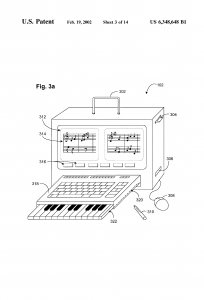
This entry goes out to my mother, who would always remark how talented Harry Connick Jr. is. This true renaissance man has had a storied career in the entertainment industry, but his most surprising work may be his inventing prowess.
Just take a look at his “System and method for coordinating music display among players in an orchestra” ( US 6,348,648). The device allows someone to edit and write notes on a piece of music and then immediately transmit it to the other musicians in the orchestra via a separate screen. The invention had a piano keyboard and computer interface that would convert the changes into music notes for on the fly editing and music directing. The patent was granted to the “It Had to Be You” signer back in 2002. I guess Harry was just ahead of the game in going paperless!
An Instrument Support That Allows the User to “Jump”
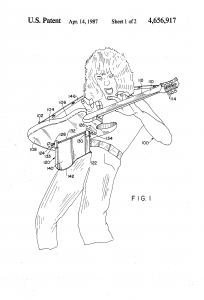
Edward L. Van Halen, better known as “Eddie,” was the co-founder and guitarist for hair metal heroes, Van Halen. Considered one of the greatest guitarists ever, his tapping and shredding riffs helped cement Van Halen as one of the best-selling groups of all time. But equally prolific were his inventing abilities, which he used to further his playing.
The “Musical instrument support” (US 4,656,917) was intended to attach to stringed musical instruments like guitars, banjos, and mandolins. By using a plate, the support enabled the musician to rest the instrument on their leg, freeing their hands to perform a wider variety of techniques. Van Halen used this support to help him test the limits of guitar playing, and it’s safe to say: it rocked.
Champagne Music and Cigarette Inventions
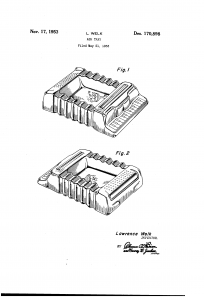
This next musician was a fixture in the Big Band era of the ‘30s and ‘40s before launching his own show. Ask your parents and grandparents, and I’m sure they remember the accordion, bandleader, and polka king Lawrence Welk. While his “champagne music” was polarizing back in the day, his invention also comes straight out of the pages of yesteryear.
To say Welk loved the accordion is an understatement. His love was so strong that he designed several patents with the accordion in mind. Everyday items like a lunchbox (D157110) and an ash tray (D 170898) suddenly became accordions thanks to Welk’s design patents. Nothing can come between a man and his accordion!
A Mic Stand That Does More than Stand “Straight Up”
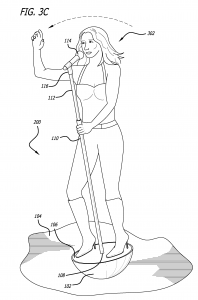
Before she was a fixture on American Idol, Paula Abdul was a pop megastar who even tied the record for most number-one singles from a debut album. A former Lakers cheerleader, her performances involved in-depth choreography that had the singer moving all over the stage. This is where she came up with the idea for her patent.
Published in 2009, Abdul’s patent application for a “Dynamic microphone support apparatus” (20090196451A1) was meant to enhance her stage shows by providing unique choreography. The apparatus had a rounded base with adhesives, as well as a rod that would hold a microphone. This enabled the singer to tilt and rock while standing on the base, staying stable thanks to the adhesives. In case you’re looking for a way to “Dance Like There’s No Tomorrow” while flexing your vocal skills, Paula’s patent application has you covered! And, because this application was apparently abandoned, you can follow it without fear of liability!
The Outro and Beyond
I hope by now you’ve seen that it’s not just scientists who can be patent-holders. As music and concerts get bigger, more experimental, and more technical, keep an eye out for other musicians with an inventive spirit. Who knows – maybe you’ll be inspired to create the next keytar, mic stand, or train set just by listening to some tunes!
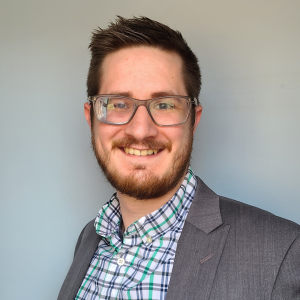
Andy Sutherland
Associate Blogger
Loyola University School of Law, JD 2023
